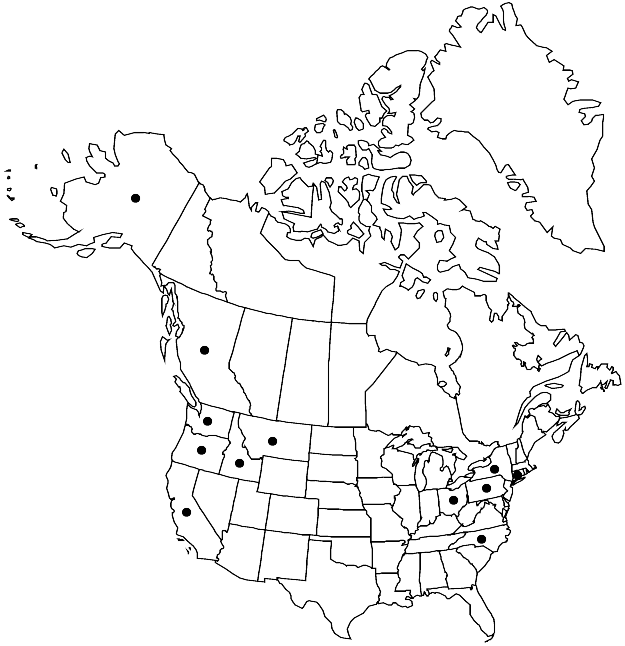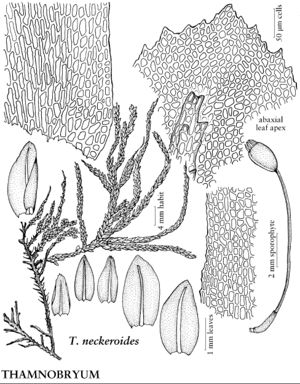Difference between revisions of "Thamnobryum neckeroides"
Moss Fl. Pacif. N.W., 245. 1971.
FNA>Volume Importer |
imported>Volume Importer |
||
| (6 intermediate revisions by 2 users not shown) | |||
| Line 9: | Line 9: | ||
|special_status={{Treatment/ID/Special_status | |special_status={{Treatment/ID/Special_status | ||
|code=F | |code=F | ||
| − | |label= | + | |label=Illustrated |
}} | }} | ||
| − | |basionyms={{Treatment/ID/ | + | |basionyms={{Treatment/ID/Basionym |
|name=Hypnum neckeroides | |name=Hypnum neckeroides | ||
|authority=Hooker | |authority=Hooker | ||
| + | |rank=species | ||
| + | |publication_title=Musci Exot. | ||
| + | |publication_place=1: plate 58. 1818 | ||
}} | }} | ||
|synonyms= | |synonyms= | ||
| Line 29: | Line 32: | ||
|elevation=moderate elevations | |elevation=moderate elevations | ||
|distribution=B.C.;Alaska;Calif.;Conn.;Idaho;Mont.;N.Y.;N.C.;Ohio;Oreg.;Pa.;Wash.;Europe (Czech Republic;Germany;Italy);Asia. | |distribution=B.C.;Alaska;Calif.;Conn.;Idaho;Mont.;N.Y.;N.C.;Ohio;Oreg.;Pa.;Wash.;Europe (Czech Republic;Germany;Italy);Asia. | ||
| − | |discussion=<p>Thamnobryum neckeroides is distinguished by the distinctly concave, almost boat-shaped branch leaves, and the rounded to broadly rounded apex. The apical laminal cells are mostly subquadrate to short-rhomboidal and the medial juxtacostal cells have their longest axis parallel to the costa.</p> | + | |discussion=<p><i>Thamnobryum neckeroides</i> is distinguished by the distinctly concave, almost boat-shaped branch leaves, and the rounded to broadly rounded apex. The apical laminal cells are mostly subquadrate to short-rhomboidal and the medial juxtacostal cells have their longest axis parallel to the costa.</p> |
|tables= | |tables= | ||
|references={{Treatment/Reference | |references={{Treatment/Reference | ||
| Line 41: | Line 44: | ||
-->{{#Taxon: | -->{{#Taxon: | ||
name=Thamnobryum neckeroides | name=Thamnobryum neckeroides | ||
| − | |||
|authority=(Hooker) E. Lawton | |authority=(Hooker) E. Lawton | ||
|rank=species | |rank=species | ||
| Line 54: | Line 56: | ||
|publication title=Moss Fl. Pacif. N.W., | |publication title=Moss Fl. Pacif. N.W., | ||
|publication year=1971 | |publication year=1971 | ||
| − | |special status= | + | |special status=Illustrated |
| − | |source xml=https:// | + | |source xml=https://bitbucket.org/aafc-mbb/fna-data-curation/src/2e0870ddd59836b60bcf96646a41e87ea5a5943a/coarse_grained_fna_xml/V28/V28_967.xml |
|genus=Thamnobryum | |genus=Thamnobryum | ||
|species=Thamnobryum neckeroides | |species=Thamnobryum neckeroides | ||
Latest revision as of 21:39, 5 November 2020
Plants (4–)6–8(–10.5) cm. Secondary stem leaves 2–3.2 × 1–1.7 mm. Branch leaves oblong-ovate to ovate, 1–2.2 × 0.5–0.8 mm; margins serrate at apex; apex obtuse to broadly acute; basal laminal cells 5–8 × 1–2 µm; medial juxtacostal cells long-rhomboidal, longest axis parallel to costa, 3–5 × 1–3 µm; apical cells subquadrate to short-rhomboidal, 2–4 × 1–2 µm. Sexual condition dioicous.
Habitat: Rock, humus, base of trees, shaded banks, boulders, cliffs
Elevation: moderate elevations
Distribution

B.C., Alaska, Calif., Conn., Idaho, Mont., N.Y., N.C., Ohio, Oreg., Pa., Wash., Europe (Czech Republic, Germany, Italy), Asia.
Discussion
Thamnobryum neckeroides is distinguished by the distinctly concave, almost boat-shaped branch leaves, and the rounded to broadly rounded apex. The apical laminal cells are mostly subquadrate to short-rhomboidal and the medial juxtacostal cells have their longest axis parallel to the costa.
